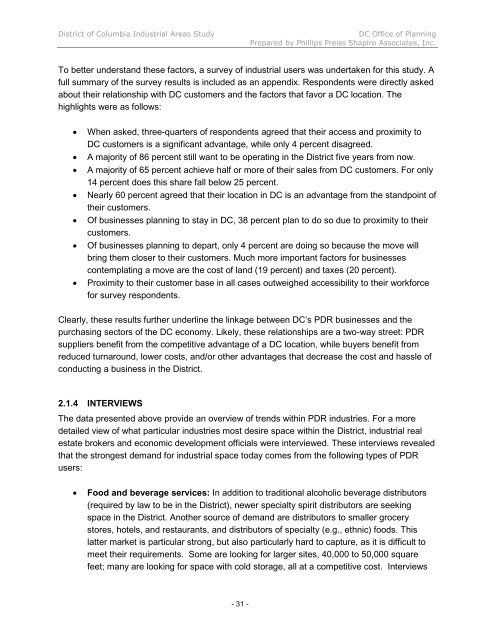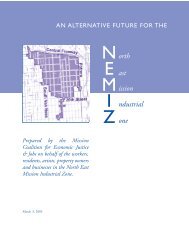INDUSTRIAL LAND IN A POST-INDUSTRIAL CITY District of ...
INDUSTRIAL LAND IN A POST-INDUSTRIAL CITY District of ...
INDUSTRIAL LAND IN A POST-INDUSTRIAL CITY District of ...
Create successful ePaper yourself
Turn your PDF publications into a flip-book with our unique Google optimized e-Paper software.
<strong>District</strong> <strong>of</strong> Columbia Industrial Areas Study DC Office <strong>of</strong> Planning<br />
Prepared by Phillips Preiss Shapiro Associates, Inc.<br />
To better understand these factors, a survey <strong>of</strong> industrial users was undertaken for this study. A<br />
full summary <strong>of</strong> the survey results is included as an appendix. Respondents were directly asked<br />
about their relationship with DC customers and the factors that favor a DC location. The<br />
highlights were as follows:<br />
When asked, three-quarters <strong>of</strong> respondents agreed that their access and proximity to<br />
DC customers is a significant advantage, while only 4 percent disagreed.<br />
A majority <strong>of</strong> 86 percent still want to be operating in the <strong>District</strong> five years from now.<br />
A majority <strong>of</strong> 65 percent achieve half or more <strong>of</strong> their sales from DC customers. For only<br />
14 percent does this share fall below 25 percent.<br />
Nearly 60 percent agreed that their location in DC is an advantage from the standpoint <strong>of</strong><br />
their customers.<br />
Of businesses planning to stay in DC, 38 percent plan to do so due to proximity to their<br />
customers.<br />
Of businesses planning to depart, only 4 percent are doing so because the move will<br />
bring them closer to their customers. Much more important factors for businesses<br />
contemplating a move are the cost <strong>of</strong> land (19 percent) and taxes (20 percent).<br />
Proximity to their customer base in all cases outweighed accessibility to their workforce<br />
for survey respondents.<br />
Clearly, these results further underline the linkage between DC’s PDR businesses and the<br />
purchasing sectors <strong>of</strong> the DC economy. Likely, these relationships are a two-way street: PDR<br />
suppliers benefit from the competitive advantage <strong>of</strong> a DC location, while buyers benefit from<br />
reduced turnaround, lower costs, and/or other advantages that decrease the cost and hassle <strong>of</strong><br />
conducting a business in the <strong>District</strong>.<br />
2.1.4 <strong>IN</strong>TERVIEWS<br />
The data presented above provide an overview <strong>of</strong> trends within PDR industries. For a more<br />
detailed view <strong>of</strong> what particular industries most desire space within the <strong>District</strong>, industrial real<br />
estate brokers and economic development <strong>of</strong>ficials were interviewed. These interviews revealed<br />
that the strongest demand for industrial space today comes from the following types <strong>of</strong> PDR<br />
users:<br />
Food and beverage services: In addition to traditional alcoholic beverage distributors<br />
(required by law to be in the <strong>District</strong>), newer specialty spirit distributors are seeking<br />
space in the <strong>District</strong>. Another source <strong>of</strong> demand are distributors to smaller grocery<br />
stores, hotels, and restaurants, and distributors <strong>of</strong> specialty (e.g., ethnic) foods. This<br />
latter market is particular strong, but also particularly hard to capture, as it is difficult to<br />
meet their requirements. Some are looking for larger sites, 40,000 to 50,000 square<br />
feet; many are looking for space with cold storage, all at a competitive cost. Interviews<br />
- 31 -












